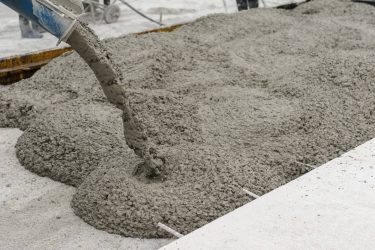When I was younger, my neighbors decided to put up a wooden fence between us and them to keep my siblings and me out of their backyard. While that might’ve been the best choice to keep their tulips safe from our roughhousing, their choice in material might not have been. The two most common materials for fence posts are concrete and wood, one of them is better in the long run.
Although it takes a lot of effort and a bit more money to install a concrete fence post, they are worth the hassle in comparison to wooden fence posts. Concrete is a more stable and sturdy material that can withstand most outdoor forces with minimal maintenance and cost required.
While concrete and wood are both worthy materials to use for fence posts, the reasonings below prove that the investment of using concrete will pay off more in the end.

Table of Contents
Which fence post is most durable; Wood or Concrete?
Concrete is made out of strong materials such as rocks and dry portland cement powder. Due to the sturdy materials that comprise the concrete mixture, it doesn’t degrade over time as quickly as the wood does and it is not susceptible to as many problems.
Wood is prone to insects and rot. Insects like termites, carpenter ants and different types of beetles love to find wood to eat and live in. This kind of infestation of the fence post will leave the wood weak and unable to provide support for the structure.
Rotten wooden fence posts tend to look darker, cracked, and more malleable than normal wood. This rot caused by fungi will eat away at the important structural part of the wood.
It not only leaves the fence weaker but also causes the appearance of your fence to be unattractive. If left untreated, these fungi can spread to other parts of your fence and compromise the integrity of the structure.
Wooden fence posts are also more susceptible to water damage that can cause splitting and warping.
Splitting in wooden fence posts occurs when water or moisture is able to seep into the wood itself causing it to expand and get bigger. As the moisture eventually dries, it causes the wood to shrink and thereby creates unwanted stress on the wooden post.
This stress will cause the post in time to split and compromise the strength of the post. To the same degree, a wooden fence post can warp when the moisture in a wooden fence post dries at different rates causing it too to become weaker and unstable to support a fence.
Related article: Can Concrete Fence Posts Be Drilled
What type of fence post lasts the longest?
It is no secret that concrete is a long-lasting material. Many structures built out of this mixture hundreds of years ago still stand tall today.
So why not use this type of material for a fence post to stand for the duration of the fence’s life?
Concrete fence posts can last 20 years easily with minimal maintenance required to keep their sturdiness.
Whereas, the wood used as fence posting lasts 10-15 years if treated with a stain or preservative but as short as 5 years if not treated.
Do Wooden Fence posts or concrete fence posts look best?
Beauty is in the eye of the beholder, and in this case, in the eye of the fence owner.
This is all based on personal preference and by how much you or others will look at the fence. The look of wood vs concrete differs a lot, and most people usually have a preference.
Using wood as the material for a fence post can produce more of a classic look as it blends in better with the natural environment around it outside.

Having concrete fence posts can bring a modern, sleek look to your backyard that can be more desirable to some people who like a more updated style.
Are concrete fence posts cheaper than wood?
Wooden fence posts are much cheaper to both buy and install.
It costs on average about $30 per wooden fence post and $100 per concrete fence post.
While it does initially cost more money to install a concrete fence post than a wooden one, it may end up being cheaper in the long run.
Since wood is an easier material to source, it tends to be cheaper to use as a fence post. But wood doesn’t last as long as concrete does.
A wooden fence post will need to be replaced multiple times throughout the fence’s lifetime costing you at least $30 each time for each post. However, it’s much easier (and cheaper) to replace a wooden fence post than a post made of concrete.
Related Article: How To Remove a Broken Fence Post Set in Concrete
Due to the concrete’s long-lastingness, it does not have to be replaced even close to how often a wooden one needs to and will therefore be a cheaper choice in the end.
To summarize, concrete fence posts are much more expensive to install but if you plan to have the fence for a very long time, it might be cheaper in total calculating the maintenance costs.
It’s Much Faster & Easier to Install Wooden Posts
If a speedier and easier process is desired when installing fence posts, then wood is the best option.
Weight is the big deciding factor in this situation. While a concrete fence post weighs about 40 kg (88 pounds), wood fence posts do not weigh nearly as much.
Due to the heavier weight of concrete fence posts, they take a longer time to install to ensure that it is done correctly and safely.
It takes even more effort to install a concrete post than a wooden post so it usually requires more people to do it, in comparison with the one to two people needed to install a lighter wooden fence post.
Read more: How To Set a Post in Concrete Without Mixing
Also, the transportation of the two types of fence posts differs a lot. Wood is absolutely the best option in this regard.
Wood Is More Environmentally Safe Than Concrete
Concrete is known as the ‘most destructive material on Earth’. Taking into account all of the processes used to create concrete, it is responsible for 4-8% of the generated CO2 in the world today.
“Half of concrete’s CO2 emissions are created during the manufacture of clinker, the most-energy intensive part of the cement-making process.” Source
Concrete can also cause damage to the topsoil of the Earth. Most wood these days is sourced from trees that are grown specifically to be used as timber.
Although the cutting down of trees does harm the environment in certain aspects, it is not as severe as the production of cement.
Read more: Concrete is Terrible for the Environment. Here’s Why.




